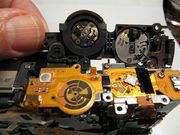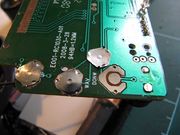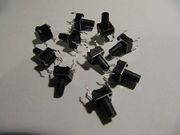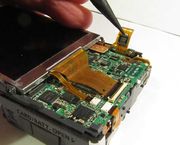Passive components: Difference between revisions
No edit summary |
mNo edit summary |
||
| Line 29: | Line 29: | ||
Modern electronic equipment often uses ribbon cables to interconnect the sub-assemblies. Sometimes the ribbon can be simply pulled out of its connector and pushed back in on reassembly, but often there is a clamp which must be pulled or lifted in order to release the ribbon. Care is required - if the clamp is broken through being pulled in the wrong direction or with too much force, it may be that little can be done. | Modern electronic equipment often uses ribbon cables to interconnect the sub-assemblies. Sometimes the ribbon can be simply pulled out of its connector and pushed back in on reassembly, but often there is a clamp which must be pulled or lifted in order to release the ribbon. Care is required - if the clamp is broken through being pulled in the wrong direction or with too much force, it may be that little can be done. | ||
[[Category:Theory]] | [[Category:Theory]] | ||
Revision as of 14:52, 22 July 2017
This page covers passive components: switches, push-buttons and connectors.
Summary
This page covers passive components: switches, push-buttons and connectors - how to identify them, what they do, how they fail and how to test them.
You can read this page on its own if you like, but if you're not already familiar with basic electrical and electronic theory you my find you get more out of it if you first read Electric circuits, volts amps watts and ohms.
Switches and Push-Buttons
Switches and push-buttons come in many different forms, and being in part mechanical, they are subject to wear and failure.
Many small switches consist of a springy metal finger which moves across one or more static metal contacts. Sometimes the pressure needs to be increased by bending the springy metal finger. If the contacts are dirty or corroded, they can be cleaned with switch cleaning fluid. In some cases the static contacts are simply tracks on a circuit board, and these can wear through. A solution may be to bend the springy metal pieces to make contact at a slightly different point.
Most push buttons rely on the click effect familiar from the safety button on screw-on metal lids to glass jars of jam, baby food and many other food products. At a critical pressure the button flips from a convex to a concave form. In a push button switch it may be a plastic film or a sliver of thin metal. In the case of metal (as illustrated from a digital alarm clock), it may be this that makes contact with a trace on a circuit board beneath, otherwise a piece of conductive rubber may bridge the gap between two circuit board traces when the button is pressed. In either case, cleaning with isopropyl alcohol or switch cleaning fluid can help.
Small push-button switches may not be repairable but can often be easily replaced. A common type is 5mm square with 4 legs connected together in pairs. On pressing the button, a connection is made between one pair and the other. Many eBay sellers offer these a range of sizes at very reasonable prices. Take care to fit the replacement in the same orientation as the original; if fitted 90 degrees out it will appear to be permanently pressed.
Connectors
Connectors are used not only to connect external devices such as a power supply or headphones, but they are also used extensively inside many devices, to interconnect the various sub-assemblies.
Connectors can often fail if they see a lot of use or are subject to strain or contamination with dirt or moisture.
Dirt and corrosion can be removed with switch cleaning fluid, available in an aerosol can, assisted by gently rubbing with a tissue. Corroded terminals in a battery compartment is a common problem, caused by chemicals leaking from long-dead batteries.
Electrical contact is normally maintained by spring pressure in some form. The pressure may be lost over time and can sometimes be restored by gently bending a springy piece of metal.
Modern electronic equipment often uses ribbon cables to interconnect the sub-assemblies. Sometimes the ribbon can be simply pulled out of its connector and pushed back in on reassembly, but often there is a clamp which must be pulled or lifted in order to release the ribbon. Care is required - if the clamp is broken through being pulled in the wrong direction or with too much force, it may be that little can be done.



